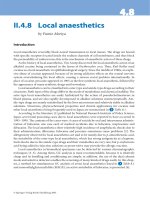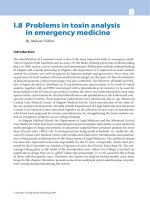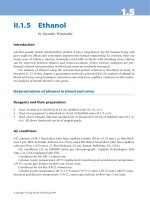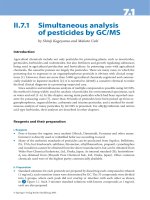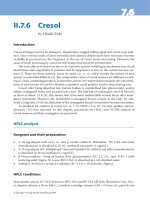Handbook of Public Administration, Third Edition pdf
Bạn đang xem bản rút gọn của tài liệu. Xem và tải ngay bản đầy đủ của tài liệu tại đây (19.05 MB, 1,266 trang )
DK3636—PRELIMS ——10/10/2006—21:24—VELU—13746—XML MODEL C–pp. 1–19
DK3636—PRELIMS ——10/10/2006—21:24—VELU—13746—XML MODEL C–pp. 1–19
DK3636—PRELIMS ——10/10/2006—21:24—VELU—13746—XML MODEL C–pp. 1–19
DK3636—PRELIMS ——10/10/2006—21:24—VELU—13746—XML MODEL C–pp. 1–19
DK3636—PRELIMS ——10/10/2006—21:24—VELU—13746—XML MODEL C–pp. 1–19
DK3636—PRELIMS ——10/10/2006—21:24—VELU—13746—XML MODEL C–pp. 1–19
DK3636—PRELIMS ——10/10/2006—21:24—VELU—13746—XML MODEL C–pp. 1–19
DK3636—PRELIMS ——10/10/2006—21:24—VELU—13746—XML MODEL C–pp. 1–19
Dedication
This book is dedicated to:
Dr. Joseph T. Acri
Rhonda N. Hildreth
Reba and Cecil Miller
DK3636—PRELIMS ——10/10/2006—21:24—VELU—13746—XML MODEL C–pp. 1–19
DK3636—PRELIMS ——10/10/2006—21:24—VELU—13746—XML MODEL C–pp. 1–19
Preface
What better way couldtherebetocommemoratethe three-decadecollaboration of our editorial
team than to bring forth this third edition?
We have been faithful to the original model of present ing areview of the literature by major
subfields of public administration. For each subfield, there are twobibliographic treatises written by
subject matter experts from one of thesedifferent perspectives:
† Startingin1880, the development of the field’sliterature, decadebydecade
† Author opinionand analysisofthe five greattheories, concepts, or ideas that describe the
field’s literature
In addition to updated chapters, we have added twonew units, one on information technology
and the other on conductofinquiry.
We editors are grateful to each chapter author, not only for their willingness to share their
intellectual contributions, but also for their diligent labors. We hope that this book will be as
well receivedbythe profession as were the previous two—insum,the industry standard as is
befitting the first attempt to develop acomprehensive volume dealing with the vast field of public
administration.
We all welcome your comments and suggestions.
Jack Rabin
W. Bartley Hildreth
Gerald J. Miller
DK3636—PRELIMS ——10/10/2006—21:24—VELU—13746—XML MODEL C–pp. 1–19
DK3636—PRELIMS ——10/10/2006—21:24—VELU—13746—XML MODEL C–pp. 1–19
Editors
Jack Rabin is aprofessorofpublic administrationand public policy at ThePennsylvania State
University—Harrisburg,Middletown, Pennsylvania. Previously,hewas an associate professor and
chair in the graduate program in human services administration at Rider College in Lawrenceville,
New Jersey. He serves as editor/coeditorofseven journals: the International Journalof
Organization Theory and Behavior and the International JournalofPublic Administration (both
journals, Marcel Dekker, Inc.), Public Administration Quarterly,the JournalofHealth and Human
ServicesAdministration,the JournalofPublic Budgeting Accounting, and Financial Management,
the JournalofManagement History,and Public Administration and Management: An Interactive
Journal .Dr. Rabin is author, editor,orcoeditorof25books, including the Handbook of Public
Budgeting,the Handbook of Public Personnel Administration,the Handbook of Public Sector
LaborRelations, Poli tics andAdministration, Managing Administration,State andLocal
Government Administration,the Handbook of Information Resource Management,the Handbook
on Human ServicesAdministration,the Handbook of Strategic Management ,and Public Budgeting
and Finance (all booktitles, Marcel Dekker, Inc.). Dr.Rabin, moreover, was aconsultant in
budgetingand strategic planning in the executive office of the Presidentofthe United States. He
also serves as executive editor of the PublicAdministration and Public Policy Series (Marcel
Dekker, Inc.). Dr.Rabin received aPh.D. (1972) in politicalscience from the University of
Georgia, Athens.
W. Bartley Hildreth is regents distinguished professorofpublic finance at the Hugo Wall School
of Urban and Public Affairs and the W. Frank Barton School of Business, and directorofthe Kansas
Public Finance Center, WichitaStateUniversity, Kansas. Dr.Hildrethhas served as director of
finance for the city of Akron, Ohio; associate professor of finance and public administrationinthe
graduate school of management at Kent State University, Ohio; prof essor of public administratio n
in the College of Business Administration at Louisiana State University, Baton Rouge; and former
chair of the Association for Budget ing and Financial Management, asectionofthe American
Society for Public Admi nistration. Currently, he serves as editor-in-chief of the Municipal Finance
Journal ,book review editor of the International JournalofPublic Administration (MarcelDekker,
Inc.), memberofthe National Advisory CouncilonStateand Local Budgeting as well as the
CouncilonCertification for the Certified Public Finance Officer program of the Government
Finance Officers’Association, and board member of PFP Publishers. His work has been published
in numerous journals, such as the Public Administration Review,the American Review of Public
Administration, the Public Administration Quarterly, Public Budgeting &Finance , Public
Budgeting and Financial Management,the JournalofApplied Behavioral Science,the Review of
Public Personnel Administration, Public Personnel Management,and Public Productivity Review.
His publications also include State and Local Government DebtIssuance and Management Service.
In addition, he is the coauthor of the Stateand Local Government Budgeting Practices Handbook
and Public Budgeting Laboratory, Second Edition as well as coeditor of the Handbook of Public
Personnel Administration,the Handbook of Public Sector Labor Relations,the Handbook of
Strategic Management (editedtitles, Marcel Dekker, Inc.), Case Studies in Public Budgeting and
Financial Management,and Budgeting: Formulationand Execution.In1995, Dr. Hildrethreceived
the Donato J. Pugliese Awardfrom the Southeastern Conference for Public Administration for
his contributions to public service and administration. Aformer memberofthe Governor’s
Tax Equity Task Force and director of research for the 1995 Kansas tax reform study,
DK3636—PRELIMS ——10/10/2006—21:24—VELU—13746—XML MODEL C–pp. 1–19
Dr. Hildrethreceived aB.A. (1971) in politicalscience from the University of Alabama, an M.P.A.
(1974) from Auburn University at Montgomery, Alabama, and aD.P.A.(1979) from the University
of Georgia, Athens.
Gerald J. Miller is aprofessorofpublic administration, Rutgers, the State University of New
Jersey in Newark. Theauthor of over fifty research articles, his work has been publishedin
numerous journals in the United States and abroad, including Public Admini stration Review, Policy
Studies Journal , Public Budgeting &Finance, JournalofPublic Budgeting, Accounting &
Financial Management, Public Productivity and Management Review, International Journalof
Public Administration, Public Integrity,and Public Administration Quarterly.Having published
over twenty books, he is the author of Government Financial Management Theory and coauthor of
the Public Budgeting Laboratory.Heisthe editor of the Handbook of Debt Management and
coeditorofthe Handbook of Public Policy Analysis (with Frank Fischer and Mara Sidney),
Handbook of Research Methods in Public Administration (2d ed. forthcoming with Kaifeng Yang),
Handbook of Strategic Management (with Jack Rabin and W. Bartley Hildreth), the Handbook of
Public Personnel Administration and Labor Relati ons,and the Handbook of Public Sector Labor
Relations (both with Jack Rabin, ThomasVocino and W. Bartley Hildreth). In addition, he has
published Managerial Behavior and Organization Demands (edited with Robert T. Golembiewski
and Frank K. Gibson), Budget Management,and Budgeting: Formulation andExecution (both
edited with Jack Rabin and W. Bartley Hildreth). He is an editorial board member of the
International JournalofPublic Administration, JournalofAccounting, Public Budgeting &
Financial Management, Municipal FinanceJournal , Public Productivity and Management Review,
JournalofPublic Management,and JournalofHealth andHuman Resour ces Administration.He
serves as abook review editor for the Public Administration Quarterly.Asaformer investment
banker with the firm of Rauscher, Pierce, Refsnes, Inc. in Phoenix, Arizona, Dr.Miller continuesan
active consulting practice in the United States, Canada and WesternEurope with clientsincluding
national, state, and local governme nt organizations in legislative,executiveand judicial branches of
government, as well as private businesses and business and public sector associations such as the
Chartered InstituteofPublic Finance and Accountancy (England and Wales), the Government
Finance Officers Association of the U.S. and Canada, the World Bank, and the International City
and County Management Association. His research centers on resource allocation in nonmarket
organizations; his work has received continuous and substantial supportfrom governmentand
privatedonors in the United States, Ca nada, England and Wales, and the European Union.
Dr. Miller receivedaB.S. in economics and an M.P.A.from Auburn University. He received a
Ph.D. in politicalscience from the University of Georgia.
DK3636—PRELIMS ——10/10/2006—21:24—VELU—13746—XML MODEL C–pp. 1–19
Contributors
Matthew R. Auer
Indiana University
Bloomington, Indiana
David L. Baker
Arizona State University
Tempe, Arizona
Julia Beckett
University of Akron
Akron, Ohio
Luther F. Carter
Francis Marion University
Florence,South Carolina
N. Joseph Cayer
Arizona State University
Tempe, Arizona
David Coursey
Florida State University
Tallahassee, Florida
Peter deLeon
University of Colorado
Denver, Colorado
Robert B. Denhardt
Arizona State University
Tempe, Arizona
JamesW.Douglas
University of South Carolina
Columbia, South Carolina
David John Farmer
VirginiaCommonweal th University
Richmond, Virginia
Howard A. Frank
Florida International University
Miami, Florida
Vache Gabrielyan
American University of Armenia &
Central Bank of Armenia
Yerevan, Armenia
JohnJ.Gargan
KentState University
Kent, Ohio
G. David Garson
North Carolina State University
Raleigh, North Carolina
JamesA.Gazell
San Diego State University
San Diego, California
Robert T. Golembiewski
University of Georgia
Athens, Georgia
George M. Guess
OpenSociety Institute
Local Government and
Public Service Initiative
Budapest, Hungary
StevenW.Hays
University of South Carolina
Columbia, South Carolina
Ferrel Heady
University of New Mexico
Albuquerque, New Mexico
Marc Holzer
RutgersUniversity
Newark, New Jers ey
Jonathan B. Justice
University of Delaware
Newark, Delawar e
DK3636—PRELIMS ——10/10/2006—21:24—VELU—13746—XML MODEL C–pp. 1–19
Lawrence F. Keller
Cleveland State University
Cleveland, Ohio
Kenneth D. Kitts
Francis Marion University
Florence, South Carolina
Dale Krane
University of Nebraska at Omaha
Omaha,Nebraska
Eleanor V. Laudicina
Kean University
Union, New Jersey
Richard H. Leach
Duke University
Durham,North Carolina
Carol W. Lewis
University of Connecticut
Storrs, Connecticut
Robert P. McGowan
University of Denver
Denver, Colorado
JamesMelitski
Marist College
Poughkeepsie, New York
Gerald J. Miller
RutgersUniversity
Newark, New Jersey
Vincent Ostrom
Indiana University
Bloomington, Indiana
Alexei Pavlichev
North Carolina State University
Raleigh, North Carolina
Bruce Perlman
University of New Mexico
Albuquerque, New Mexico
Norma M. Riccucci
Rutgers University
Newark, New Jersey
Mario Rivera
University of New Mexico
Albuquerque, New Mexico
David H. Rosenbloom
American University
Washington, District of Columbia
Carl W. Stenberg
University of North Carolina
Chapel Hill, North Carolina
Fred Thompson
Willamette University
Salem, Oregon
Danielle M. Vogenbeck
University of Colorado
Denver, Colorado
Robert K. Whelan
University of New Orleans
New Orleans, Louisiana
Dennis P. Wittmer
University of Denver
Denver, Colorado
Deil S. Wright
University of North Carolina
Chapel Hill, North Carolina
Kaifeng Yang
Florida State University
Tallahassee,Florida
Samuel J. Yeager
Wichita State University
Wichita, Kansas
DK3636—PRELIMS ——10/10/2006—21:25—VELU—13746—XML MODEL C–pp. 1–19
Table of Contents
Unit 1
PublicAdministration History 1
Chapter 1 Public Administration and the American Republic:
The Continuing Saga of Management and
Administration in Politics 3
Lawrence F. Keller
Chapter 2 Five Great IdeasinAmericanPublic Administration 49
Marc Holzer,Vache Gabrielyan, and Kaifeng Yang
Unit 2
Organization Theory 103
Chapter 3 Further Trends towardthe Development of the
Organizational Sciences 105
Robert T. Golembiewski
Chapter 4 Five Great Issues in OrganizationTheory 121
Robert B. Denhardt and David L. Baker
Unit 3
PublicBudgeting and Financial Management 149
Chapter 5 The Field of Public Budget ing and FinancialManagement,
1789–2004 151
Carol W. Lewis
Chapter 6 Budget Theory: New Perspectivesfor aNew Millennium 227
HowardA.Frank
Unit 4
Decision Making 249
Chapter 7 Decision Making, Institutions, Elite Control, and
Responsiveness in Public Administration History 251
JonathanB.Justiceand Gerald J. Miller
DK3636—PRELIMS ——10/10/2006—21:25—VELU—13746—XML MODEL C–pp. 1–19
Chapter 8 Five Conceptual Tools for Decision-Making 315
Dennis P. Wittmer and Robert P. McGowan
Unit 5
PublicPersonnel Management 343
Chapter 9 Public Personnel and Labor Relations 345
N. JosephCayer
Chapter 10 Managing Public Personnel: ATurn-of-the-Century
Perspective 381
LutherF.Carter and Kenneth D. Kitts
Unit 6
Federalism andIntergovernmental Relations 405
Chapter 11 Federalism, Intergovernmental Relations, and Intergovernmental
Management:The Origins, Emergence, and Maturity of Three
Conceptsacross Two CenturiesofOrganizi ng Power
by Area and by Function 407
Deil S. Wright andCarlW.Stenberg
Chapter 12 Federalism and Intergovernmental Relations: Theories,
Ideas, and Concepts 481
Dale Krane and Richard H. Leach
Unit 7
PublicPolicy 501
Chapter 13 Back to Square One: The History and Promiseofthe
Policy Sciences 503
PeterdeLeon and Danielle M. Vogenbeck
Chapter 14 The Policy Sciences in Critical Perspective 541
MatthewR.Auer
Unit 8
Comparative andInternational Relations 563
Chapter 15 Comparative and International Administration 565
George M. Guess and Vache Gabrielyan
DK3636—PRELIMS ——10/10/2006—21:25—VELU—13746—XML MODEL C–pp. 1–19
Chapter 16 Issues in Comparative and International Administration 605
FerrelHeady, Bruce Perlman, and Mario Rivera
Unit 9
PublicLaw 633
Chapter 17 Administrative Law and Regulation 635
David H. Rosenbloom
Chapter 18 Five Great Issues in Public Lawand Public Administra tion 697
Julia Beckett
Unit 10
PublicAdministration Pedagogy 721
Chapter 19 AHistory of PedagogyinPublic Administration 723
Eleanor V. Laudicina
Chapter 20 Public Administration Pedagogy: What Is It? 757
Norma M. Riccucci
Unit 11
Information Technology 767
Chapter 21 The Evolution of Information Technology in the
Public Sector 769
James Melitski
Chapter 22 Strategically Managing Information Technology:
Challengesinthe e-Gov Era 781
David Coursey
Chapter 23 Five Great IdeasinPublic Information Technology
Literature 797
Alexei Pavlichev and G. David Garson
Unit 12
The ConductofInquiry 823
Chapter 24 AHistory of the Conduct of Inquiry in
Public Administration 825
Robert K. Whelan
DK3636—PRELIMS ——10/10/2006—21:25—VELU—13746—XML MODEL C–pp. 1–19
Chapter 25 Classic Methods in Public Administration Research 851
Samuel J. Yeager
Unit 13
Judicial Administration 981
Chapter 26 JudicialAdministration: Modernizing the Third Branch 983
Steven W. Haysand James W. Douglas
Chapter 27 Five Great Issues in Judicial Administration 1029
James A. Gazell
Unit 14
Political Economy 1061
Chapter 28 The Political EconomyofPublic Administration 1063
Fred Thompson
Chapter 29 Some Developments in the Study of Market Choice,Public
Choice,and Institut ional Choice 1101
Vincent Ostrom
Unit 15
PublicAdministration as aProfession 1123
Chapter 30 The Public Administration Community and the Search
for Professionalism 1125
John J. Gargan
Chapter 31 Five Great Issues in the Profession of
Public Administration 1205
David John Farmer
Index 1221
DK3636—PRELIMS ——10/10/2006—21:25—VELU—13746—XML MODEL C–pp. 1–19
Unit 1
Public Administration History
DK3636—UNIT 1—5/10/2006—17:23—VELU—XML MODEL C–pp. 1
1
Public Administration and
the American Republic: The
Continuing Saga of Management
and Administration in Politics
Lawrence F. Keller
CONTENTS
I. Introduction 3
II. Administration, Politics, and History: Three Legacies of Republican Governance 5
III. The1880s: Intimations and Foundations 8
IV.The 1890s: Prelude Continued 9
V. The1900s: Transformations in Practice 10
VI.The 1910s: Reform Continued and Intensified 11
VII. The1920s: Maturation of the Public Interest Model 12
VIII. The1930s: TheRise of the Administrative State 13
IX.The 1940s: Reflection on the AdministrativeState 15
X. The1950s: TheBeginnings of Self-Awareness 17
XI.The 1960s: Beyond Political Science 19
XII. The1970s: Identity Revisited, New Currents and Curriculum 21
XIII. The1980s: Crosscurrents and aReturn to Basics 24
XIV. Public Administration in the 1990s: Reshaping Management,Searching
for Macro Legitimacy 28
XV. Conclusion:Public Administration and the Search for Governance
in aGlobal Security State 32
XVI. Dedication 35
References 35
I. INTRODUCTION
In lightofthe numerous significant politicaland economic issues,one wouldexpect
public administrationalso to experience avariety of issues. It is, after all, in if not of politics.
The study and practice of public administration are indeed under scrutiny. Concerns range from the
nature of itsmanagerialpremises to itsability to carryout theaffairs of statefor whichit
was created. Acontinuing populism (Rosenbloom 1993a)fed by Americans’ distrust of government
3
DK3636—CHAPTER 1—10/10/2006—21:30—VELU—13747—XML MODEL C–pp. 3–48
as well as advances in informationtechnology provide forinstantpopular opinion and
government by initiative. The Internet alongwith cable television provides avenue for all types
of groups to advocate for their own interests and ideologies. Starting with the presidency of Richard
Nixon, politicalexecutives see less and lessvalueinahigh level civil service. Consequently, the
recently createdDepartment of Homeland Security does not provide civil service to its employees.
National level politics continue to become increasingly partisan, sometimes exacerbated by adher-
ence to strongly expressed,ifnot strident, ideologies.Atthe municipal level, electedofficials
increasingly questionthe executive authority of city managers, apparently elevating election as
empowerment rather than amethod of selecting an officeholder. These developments questionthe
degreetowhich independent and professionallytrained administrators can provide responsive and
responsible government. They alsoraise important questions about some fundamental premises
upon which the studyand evolution of public administration has been based. Withinthe field, many
scholars, following in the footsteps of Dwight Waldo (1948),continue to question the foundations
of both the studyand the practice, critically examining its so-called scientific roots and an often
implicitpoliticalphilosophy (Farmer 1998; Foxand Miller 1995; Spicer1995).
This chapter is organized, as were previous editions of the chapter, to review, decadeby
decade, the history and organization of the study andpractice of publicadministration.This
historyillustratesthe peculiar mix of eventsand peoplethat influenced the direction of apractice,
if not aprofession, and afield of study.
*
Major highlights are preserved, although some illustra-
tive materials have been deleted and others arranged differently. Eventsand peopleinpublic
administrationare linked to contemporaryevents and trends. Thus, the chapter starts with major
politicalissues, as the field and profession are part of the larger society. All is organizedby
ascertaining the influence of three models of governance on the field. These are explicatedinthe
following section.
Theimportance of public administrationderives from its crucial role in the governing of a
society(Rohr1986). Governance is best illuminated by examiningpolitico-administrative
systems. Accordingly, viable images or models areimportant toolstoguide researchand
reflectpractice (Boulding 1956; Kass and Catron 1990;Morgan 1986). For example, Bailey
(1968) and Henry (1975) suggest that the scope of public administrationconcerns normative
questions about the “oughts” of administration, an openness to technology and management,and
regard for the impacts of individuals and organizations on public sector policy and management.
In addition,the “refounding”movementhas refocused attention to theroleofpublic
administrationingovernance.Otherscall attention to the role of Law and the Constitution in
thepractice(Cook 1996; Cooper1992;Rohr1986;Rosenbloom,Carroll andCarroll2000;
Wamsley andWolf 1996).Ininternational affairs, ascholar haspungently questionedhow
global economicdevelopment hasbeenpursued.Hearguesforcefully that many lessons of
Public Administration have been ignored (Fukuyama 2004). Emphatically,henoted that
current efforts in global economicdevelopment were based on a“black hole of public admin-
istration.” These ignored seventy years of literature in Public Administration.
Historically, as politico-administrative systems, three rather distinct American models can be
identified, with each having widelydifferent roles for public administration. Each connects with the
normative sides of different disciplines. Thus, to understand the history requires abrief examination
of the rise and content of the three models.
*
Michael Foucault, in another context, described the utility of such an approach in the following way: [T]o follow the
complex course of descent is to maintain passing events in their proper dispersion; it is to identify the accidents, the minute
deviations—or conversely, the complete reversals—theerrors, the false appraisals, and the faulty calculations that gave
birth to those things that continue to exist and have value for us; it is to discover that truth or being do not lie at the root of
what we know and what we are but the exteriority of accidents (Foucault 1976, 146).
Handbook of Public Administration4
DK3636—CHAPTER 1—10/10/2006—21:31—VELU—13747—XML MODEL C–pp. 3–48

